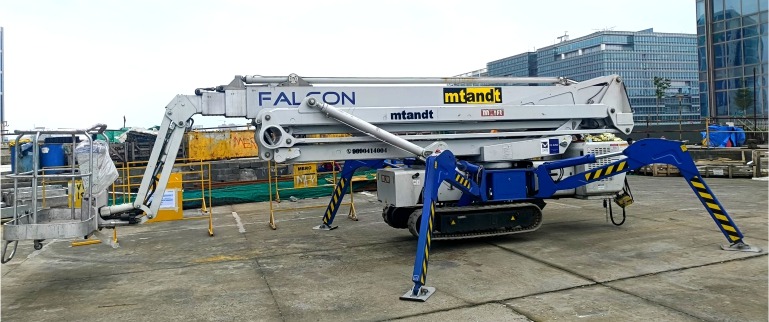It was a quiet Monday morning in a bustling airport terminal in Chennai. Inside, a Mtandt operator carefully maneuverer a crawler-mounted spider lift through narrow sliding doors, heading for a set of ceiling lights 14 meters up. Across town, another crew was setting up a 52‑meter spider lift on uneven ground at a solar power site.
Though both lifts belong to the same family, their jobs couldn’t be more different—one working on polished indoor floors, the other tackling rugged outdoor terrain. Choosing the right spider lift for indoor vs outdoor environments can make or break the job—impacting safety, efficiency, and cost.
This guide, drawn from Mtandt Rentals’ 50 years of expertise, will help you understand what to look for when selecting the right spider lift for your job site.
1. What Is a Spider Lift—and Why Choose One?
Spider lifts are compact aerial work platforms with distinctive, spiderlike outriggers for stability. At
Mtandt Rentals, they are available in:
- Working heights: 12 m to 52 m
- Mounting types: Wheel or crawler
- Power options: Battery (electric) or hybrid engines
Why they work:
- Compact & versatile: Can pass through standard doorways and reach up to 52m outdoors (depending on model).
- Safe & stable: Outriggers self-level on uneven ground for secure operation.
- Ecofriendly options: Battery-powered lifts allow zero-emission indoor work.
- Adaptable for any terrain: Crawler-mounted models thrive on rough, muddy, or sloped surfaces.
2. Choosing Spider Lifts for Indoor Sites
Indoor work—airports, malls, factories—requires precision and protection.
What to look for:
- Battery powered models: Quiet, no fumes, safe for enclosed spaces.
- Non-marking tracks or wheels: Protect delicate flooring like marble or tile.
- Compact dimensions: Fits through doors and corridors.
- Working height range: 12 m to 18 m covers most indoor jobs (e.g., lighting, HVAC maintenance, indoor painting).
Example use cases:
- Mall ceiling maintenance
- Theatre lighting work
- Factory machinery service
Why not use diesel indoors? Fumes, noise, and weight make it unsafe and impractical.
3. Choosing Spider Lifts for Outdoor Sites
Outdoor environments—construction sites, solar farms, bridges—demand reach, strength, and stability.
What to look for:
- Crawler-mounted versions: Handle mud, gravel, and slopes with ease.
- Diesel or hybrid power: Delivers the endurance needed for long, rugged tasks.
- Wider reach: Models up to 52 m handle high façade repair, bridge inspection, tree care.
- Outriggers: Automatically level the lift on uneven or sloped ground.
Example use cases:
- Solar panel installation
- Bridge & façade inspections
- Tree pruning or landscaping at height
4. Indoor vs Outdoor: Quick Comparison
|
Criteria
|
Indoor Spider Lifts |
Outdoor Spider Lifts |
|
Working Height
|
12–18 m |
Up to 52 m
|
|
Power Type
|
Battery (quiet, zero emissions) |
Diesel or hybrid
|
|
Mounting
|
Wheel or light crawler |
Heavy-duty crawler
|
|
Floor/Terrain
|
Non-marking, sensitive floors |
Uneven, rough ground
|
| Noise & Emissions |
Silent, eco-friendly
|
Outdoor-tolerant
|
5. Spider Lifts vs Other MEWPs
Spider lifts fill the niche between scissor lifts (great for flat, vertical work indoors) and boom lifts (excellent reach but too bulky for tight spaces).
- Why not always use a boom lift outdoors? Boom lifts are heavier and require large, stable ground. Spider lifts are lighter, safer on fragile terrain, and easier to transport.
- Why not always use scissor lifts indoors? Scissor lifts can’t reach over obstacles; spider lifts have articulating arms for tricky angles.
6. Mtandt’s Spider Lift Range
Mtandt Rentals offers wheel and crawler-mounted spider lifts:
- Compact Indoor Units (12–18 m): Perfect for malls, warehouses, and atriums.
- Mid‑Range Dual-Power (20–35 m): Flexibility for mixed use.
- High Reach Outdoor Units (35–52 m): Diesel-powered for demanding jobs like façade work or bridge inspection.
7. Safety & Best Practices
- Always use certified operators trained for MEWPs.
- Inspect outriggers, tracks, and controls before use.
- Confirm floor load limits indoors; check ground firmness outdoors.
- Use harnesses and anchorage points on all lifts.
8. Decision Checklist for the Right Spider Lift
- Job site type: Indoor or outdoor?
- Required height: 12 m, 18 m, or up to 52 m?
- Access restrictions: Door width, corridor space?
- Terrain: Smooth flooring or muddy slopes?
- Power source needed: Battery, diesel, or hybrid?
- Operator certification & safety protocols in place?
9. Why Should You Pick Mtandt?
When it comes to working safely at height, choosing the right equipment partner is just as important as choosing the right machine.
Mtandt Rentals isn’t just another rental provider—we’re a 50-year-strong industry leader known for trust, safety, and innovation. Our spider lift range, spanning 12 m to 52 m working heights, is one of the most comprehensive and versatile fleets in India, designed to handle everything from delicate indoor maintenance to demanding outdoor construction.
By choosing Mtandt, you get:
- Expert guidance to match the right spider lift to your job—no guesswork.
- Meticulously maintained equipment for maximum safety and reliability.
- Flexible rental plans that keep your project on schedule and budget.
- Certified training & support, ensuring your operators work confidently and safely.
In short: Mtandt doesn’t just rent you a spider lift—we partner with you to make every job faster, safer, and hassle‑free.
Final Word
The right spider lift isn’t just about height—it’s about where and how it will be used.
- Indoors? Battery-powered, compact, non-marking spider lifts.
- Outdoors? Diesel or hybrid, crawler-mounted spider lifts with outriggers for rugged terrain.
By aligning jobsite needs with
Mtandt’s spider lift fleet, you gain maximum productivity, safety, and value—whether it’s changing lights in an airport atrium or repairing a façade 50 meters up.
Contact Us
